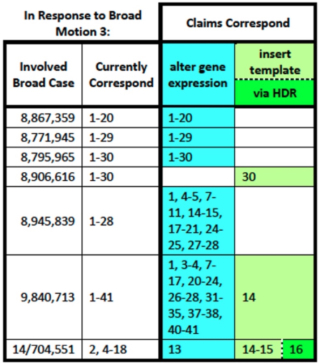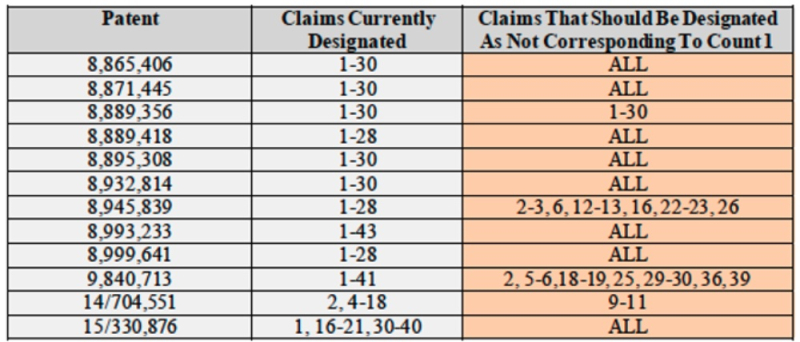On December 3rd, Junior Party the Broad Institute, Harvard University, and MIT (collectively, Broad) filed its Contingent Preliminary Motion No. 3 in Interference No. 106,133 (which names Sigma-Aldrich as Senior Party), asking the Patent Trial and Appeal Board to designate certain claims deemed in the Declaration as corresponding to the Interference Count as not having such correspondence, under 37 C.F.R. §§ 41.121(a)(1)(i) and 41.207(b)(2). Senior Party Sigma-Aldrich filed its Opposition on March 16th and Broad filed its Reply on April 26th.
As argued by Broad, these claims fell into five discrete categories:
Category A: Staphylococcus aureus Cas9 protein ("SaCas9");
Category B: Cas9 chimeric CRISPR enzyme;
Category C: Cas9 with two or more nuclear localization signals ("NLSs");
Category D: Cas9 fused to specified protein domains; and
Category E: Claims that are generic as to RNA and also do not specify integration of a donor polynucleotide sequence ("Donor Template Integration" claims), i.e., the only claims that should remain designated as corresponding to Count 1 are those that are either (i) limited to single molecule RNA ("sgRNA"), or (ii) require Donor Template Integration and are not otherwise separately patentable.
Broad made as a basis for its motion the distinction that the Broad portion of "McKelvey" Count 1 is directed to CRISPR-mediated cleavage in a eukaryotic cell (that "cover[s] many different inventions that are separately patentable from Count 1") while Sigma-Aldrich's portion of the Count recites CRISPR-mediated cleavage coupled with integration of a heterologous DNA molecule, termed "Donor Template Integration."
In its Opposition, Sigma-Aldrich argued that Broad failed to carry its burden to de-designate claims, inter alia, for failing to apply the "one-way obviousness" test or address the effect of prior art, including the Jinek 2012 paper, on obviousness of these claims. Sigma-Aldrich further asserted that it "endeavored to review 461 of Broad's involved claims in all 16 of Broad's involved patents and applications" and, consistent with positions Senior Party has taken in Interference No 106,132 against CVC deign not to contest de-designation of the following claim types:
(a) claims reciting more than 1 targeting RNA (aka "multiplexing");
(b) claims reciting a Cas9 protein that includes a Protein Transduction Domain (PTD);
(c) claims reciting one or more mutation(s) in the Cas9 RuvC/HNH domain(s);
(d) claims a nickase for a creating a "nick" or a single stranded break in the target DNA; and
(e) claims reciting a chimeric Cas9 protein.
And for the claims Sigma-Aldrich did contest the Opposition set forth these tables:

In its Reply, Broad sets forth its own table of what it characterizes as Sigma-Aldrich's "concessions" for claims the Board should de-designate:

Regarding the remaining claims still in dispute, Broad argues that continuing the designation of any of the claims in Category E would be inequitable because, inter alia, the "one-way" obviousness test urged by Sigma-Aldrich as a standard is not a per se rule that must be applied when the outcome would be unfair to one party. The unfairness, as Broad argued in its Motion, is that its proofs using dual-molecule RNA CRISPR embodiments without a donor template are excluded by Count 1 despite that Count encompassing such embodiments. Broad asserts that it "should not be excluded from using its earliest dual-molecule proofs for Count 1 while simultaneously putting at risk claims with the same scope." Citing Eli Lilly & Co. v. Board of Regents of University of Washington, 334 10 F. 3d 1264, 1268 (Fed. Cir. 2003), Broad argued that "the PTAB [has] the discretion to adopt a two-way test to prevent 'the proliferation of unnecessary, wasteful interference proceedings concluding that both parties are entitled to patents in situations in which the claimed inventions do not define the same patentable invention, but merely overlap in scope.'" Broad further argues that Sigma-Aldrich did not address much less refute their arguments in Motion No. 3, nor that the term "guide RNA" encompasses both single- and dual-molecule RNA components of CRISPR-Cas9 embodiments encompassed by the Count.
As it has in other Replies Broad argues that Sigma-Aldrich has improperly incorporated by reference arguments in its Opposition that were made in other Oppositions, thus achieving an expanded length of its arguments to avoid page limits, in violation of Standing Order ¶ 106.2. Broad also argues that some of Sigma-Aldrich's arguments so incorporated from its Oppositions and ex parte prosecution are contradictory to arguments made in this Opposition. The example most relevant to Broad's arguments here are Sigma-Aldrich's purported arguments elsewhere that "Donor Template Integration and other forms of cleavage and repair were separately patentable inventions, and that a POSA would not have reasonably expected success in integrating a donor template even if the art showed recognition of successful cleavage and repair in a eukaryotic cell." In sum Broad asserts that "Sigma thus repeatedly argued that Donor Template Integration and other forms of cleavage and repair were separately patentable inventions in securing its claims. Accordingly, Broad's claims that require neither sgRNA nor Donor Template Integration should be designated as not corresponding to Count 1."
For these reasons Broad asks the Board to grant its Contingent Motion No. 3 should the Board deny its Preliminary Motion No. 1.